ISSN ONLINE(2319-8753)PRINT(2347-6710)
ISSN ONLINE(2319-8753)PRINT(2347-6710)
V. Ramamurthy1, R. Rajakumar2
|
| Related article at Pubmed, Scholar Google |
Visit for more related articles at International Journal of Innovative Research in Science, Engineering and Technology
The diversity of wetlands is intermediary zones between permanently aquatic and dry terrestrial eco-systems. Wetlands require collaborated research involving natural, social and inter disciplinary studied to understanding the various components such as monitoring of water quality, socio-economic dependency, biodiversity and other activities as an indispensable tool for formulating long term conservation strategies. The physico-chemical parameters of one of the major habitats for birds, the wetlands are known to influence congregation of migratory and resident species of birds. The present study deals with the interactions between these abiotic factors and bird diversity of the Udhayamarthandapuram bird sanctuary, Tamil Nadu, India for a period of August 2011 to March 2012. During these study periods the water birds were grouped into five categories namely diving birds, swimming birds, small waders, large waders and aerial foragers. During each visit waterfowl survey was carried out and water samples were also collected to document the seasons. The variations in bird aggregations as well as physico-chemical factors are discussed. Most of the abiotic factors were significantly influenced for the density, diversity and richness of the water bird groups.
Keywords |
| Diversity, Richness, Density, water birds, abiotic factors. |
INTRODUCTION |
| Wetlands are transitional zones between permanently aquatic and dry terrestrial eco-systems. According to the Ramsar convention of the IUCN at Iran in 1981, wetlands are “submerged or water saturated lands, both natural and man-made, permanent or temporary with water, that is static or flowing, fresh, brackish or salt including areas of marine water”, the depth of which at low tides does not exceed six meters. Wetland covers about 6% of the earth’s land surface. There are several kinds of wetlands such as Marshes, Lagoons, Bogs, Fens, Open water bodies and Mangroves. India has wealth of wetland ecosystems distributed in different geographical region .Most of the wetlands in India are directly or indirectly linked with major river systems, such as Ganges, Cauvery, Godavari and Tapti. India has totally 27403 wetlands of which 23444 are inland wetlands and remaining 3959 are coastal wetlands [1]. Wetlands occupy 18.4% of the countries area (excluding river) of which 70% are under paddy cultivation. In India, it has been estimated that 4.1 million hectares are wetlands (excluding paddy fields, rivers, and streams), where as 1.5 million hectares are natural and 2.6 million hectares are manmade. The coastal wetlands occupy 6750 sq.km and are largely determined by mangrove vegetation. In Tamil Nadu it has been estimated that 31 natural wetlands covering an area of 58,068 hectares and 20,030 manmade wetland with an area of 2, 01,132 hectares [2]. The bird assemblages are affected by various factors like the food availability, the size and the abiotic changes in the wetlands [3-5]. Not only the birds but all the organisms, belonging to the plant and the animal communities, are affected by the physical characteristics of the environment [6-7]. In a wetland ecosystem these biotic factors are mostly dependent on the season and hydrology [8]. Thus wetland being an integrated system is affected by the changes in the physical as well as chemical parameters of hydrosphere at the catchment scale. These in turn, affect the wetland dependent communities as well as ecosystem attributes such as species richness, its distribution and density [9]. |
| Wetlands require collaborated research involving natural, social and inter disciplinary study aimed at understanding the various components such as monitoring of water quality, socio economic dependency, bio diversity and other activities as an indispensable tool for formulating long term conservation strategies. A first step toward that is the evaluation of physico-chemical and biological feature of wetlands that influenced their use by water birds. Thus, the physical and chemical properties of water body are characteristics of the climatic, geochemical, geomorphologic as well as pollution conditioned reviling in the drainage basin and the underlying aquifer [10]. These characteristics with natural and manmade changes determine the quality of water [11]. Thus wetlands are highly complex ecosystem due to various interactions between the components like water, soil, biosphere and atmosphere [12]. Description of Study Area Udhayamarthandapuram Lake: Udhayamarthandapuram bird sanctuary is located in Thiruvarur district of Tamil Nadu; it is an important migratory water bird habitat of Tamil Nadu. Southern India. The sanctuary was created in 1991 and has a total area of 45.30 hectares .The area coordination as 10026’’50’’ N, 79027’’58’. A large number of resident and migratory water birds visit the sanctuary from October to March every year. They come from places such as North India, Central Asia, Tibet, Ladakh and Northern Russia. The number of birds in the sanctuary is highest during November and December upto 1000 birds congregated during peak season nearly 40 species of water birds have been recorded in the sanctuary that includes species such as the White ibis, Open bill stork, Purple heron, Painted stork, Indian darter, Spoon bill, Cotton teal and Grey pelican. A globally endangered water bird such as Open bill stock up to 4000 gathers in the sanctuary during February and March 2012. |
II. MATERIALS AND METHODS |
| Population studies: Total counts of water bird densities were made for the entire lake once in a month by following method of Spindler [13] in order to avoid double counting or missing birds a vantage point was used [14]. Field binoculars (7 x 50”) were used to observe birds from all side of the lake. The birds were identified with the help of their special features [15-16] the checklist was prepared using standardized common and scientific names of the birds following Manakandan and Pittie [17]. The water bird were ecologically grouped into five categories on the basis of their activities as driving birds, swimming birds, small waders, large waders and aerial foragers Species density: The individual and total water bird densities for different months, climatic season and regions of the lake were calculated as numbers per hectare [14, 18]. The density was also calculated for all ecological groups. Species richness: Species richness was measured by the number of water bird species recorded on different regions of the lake during weekly consumes [19]. The species richness was also enumerated for all ecological groups [20]. Species diversity: In order to investigate the variations in diversity of bird species and ecological groups during different month of the study period the species diversity was calculated using Shannon wiener index [21]. Physical and chemical analysis Temperature, pH, temperature and DO were measured in the collection point, using mercury in glass Thermometer. Portable hand pH meter and the aside modification of the Winkler’s method respectively. The collected samples are immediately transferred and analysed in the laboratory. All samples analysed for various water quality parameters are determine according to standard procedure [22]. The metals were analysed using Elmer Perkin Model 8100c Atomic Absorption Spectrophotometer. Correlation analysis The bird density, diversity, richness and physic-chemical factors are correlated with the help of SPSS software. Multiple regression equation model was developed for bird population characteristics feature (density, diversity and richness) and ecological group wise Density, Diversity and Richness to investigate the influence of water quality parameter23. |
III. RESULT AND DISCUSSION |
| Water birds of Udhayamarthadapuram Lake: The present investigation is that the forty species of water birds belonging to 14 families have been identified in the waterways at the study area. Totally 65 percent of the birds identified at the study area belong to the ecological group large and small wader birds (Table 1). These birds were ecologically classified into five groups namely, Divers, Swimming birds, small waders, large waders and aerial foragers. |
| Density : The results of bird’s density characteristics were observed and recorded in the Udhayamarthadapuram Lake are presented in Fig. 1. The density of diving birds swimming birds, small waders, large waders and aerial foragers of the bird observed were slightly higher in the month of November than March. Most of the birds observed and recorded higher in monsoon followed by pre-monsoon and post-monsoon seasons. Deshkar Sona et al. [24] reported the density and species richness of birds are expected to be highest during winter when migratory population arrive and minimum during monsoon when the migratory populations leave the area and the resident species are engaged in the nesting activities. In the present study the density of diving birds swimming birds, small waders, large waders and aerial foragers of the bird observed were slightly higher in the month of November than March. The species richness of diving bird and swimming bird were higher in the month of January and lower in the month of August in the study periods. Species richness of small waders was high in the month of February and lower in September. In the other hand richness of large waders was high in the months of November and lower in August. Thus the richness of large waders was higher during monsoon season of the study periods. Most of the birds observed and recorded higher in monsoon followed by pre-monsoon and post-monsoon seasons. |
| Fig.1 A comparison of season wise variations in the bird density of the study periods |
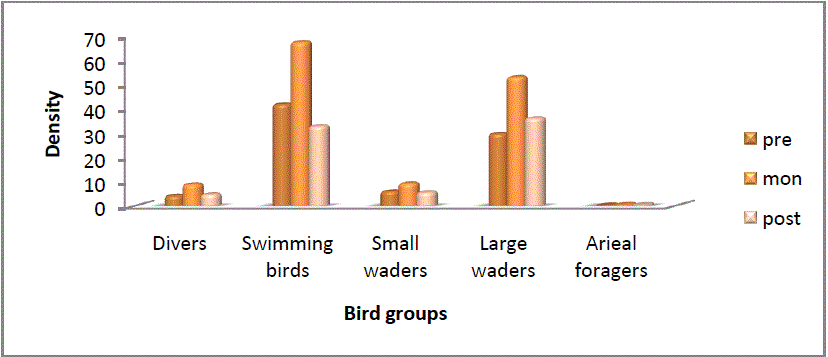 |
| Diversity : The diversity of diving birds was highest in the month of February (1.07±0.2) and lowest in August (0.5±0.1). The diversity of diving bird was higher in pre-monsoon (1.06±0.8) than monsoon and post monsoon periods. The diversity of small waders was higher in the month of November (1.67±0.1) and lower in August (1.17±0.1) and same report the diversity of large waders was higher in November (1.88±0.3) and lower in month of March (1.54±0.1). The small waders and large waders were higher in monsoon followed by post monsoon and pre monsoon. In the other hand the diversity of swimming birds and aerial foragers were higher in the month of December and lower in March. Thus the diversity of swimming bird and aerial foragers were very high during monsoon and low in pre monsoon (Fig. 2). Richness : The species richness of diving bird and swimming bird were higher in the month of January and lower in the month of August in the study periods. The species richness of diving bird and swimming bird were low in pre monsoon than post monsoon (Fig.3). Species richness of small waders was high in the month of February (9±2.6) and lower in the month of September (5±1.5). Thus the post monsoon (8.7 ± 2.2) months of the study periods had higher species richness of small waders. In the other hand richness of large waders was high in the months of November (13±1.5) and lower in the month of August (10±1.2). Thus the richness of large waders was higher during monsoon (10±1.2) season of the study periods (Fig.3). The manmade water bodies constructed by man to satisfy his own needs also form important habitats for several avian species. To study any ecosystem the birds serve as important component as they have the ability to fly away and avoid any obnoxious condition. Hence, they are considered as important health indicators of the ecological conditions and productivity of an ecosystem [25-26]. The most important parameters of the bird study are the species richness [27], their density [28] and diversity [20]. However among avian communities, the components of diversity are known to differ between locations and seasons [29]. |
| Fig.2 A comparison of season wise variations in the bird diversity of the study periods |
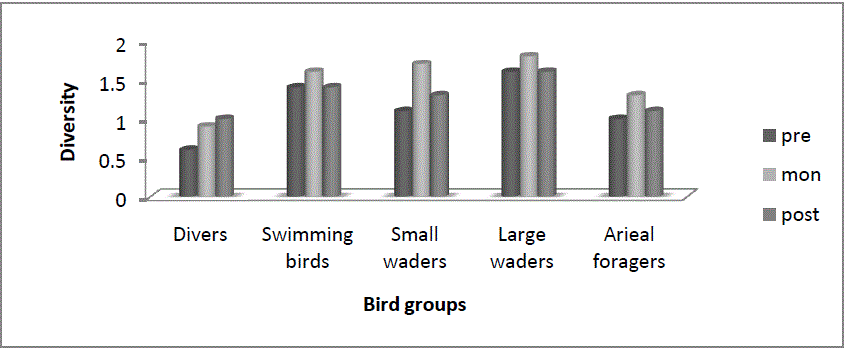 |
| Fig.3 A comparison of season wise variations in the bird richness of the study periods |
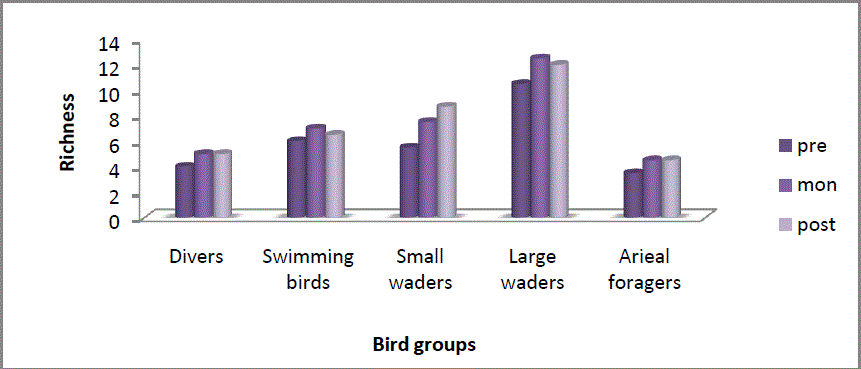 |
Physico-chemical analysis of water from the Lake |
| The results of water quality analysis and physico-chemical characteristics of lake water are presented in the table 1. The water was slightly alkaline nature and contained high amounts of pH, dissolved oxygen, electrical conductivity, salinity and turbidity in all the seasons examined. The surface water temperature was recorded highest during the post monsoon season (29.4 ± 0.12° C) than the other seasons. The water depth (115±2.62 cm) was elevated in the monsoon season. The dissolved oxygen (6.4 ± 0.1 mg/l), salinity (54.4 ± 2.9 mg/l) was increased during the post monsoon season. The turbidity (2.5±0.9 NTU) was recorded highest in the pre monsoon season during the study period. The elevated level of electrical conductivity (662.5±15.7 mho/cm) was recorded during the pre monsoon season. High amount of pH was recorded in monsoon seasons during the study periods most of the parameters were slightly higher in the post monsoon than monsoon (Table 2). As anticipated the physico-chemical parameters of water varied according to the seasonal fluctuations. Significant drop in the water cover during the post monsoon is predominantly because of the evaporation, however the water is also utilized for irrigating the neighboring fields. This also results in increasing the solids in water. The bird density was negatively correlated with water cover too. During the monsoon and the post monsoon the water level were high in turn maximum birds were present. The previous reports finding of Deshkar Sona et al. [24] during monsoon the dissolved oxygen and the salinity are high which can be due to vigorous mixing of water because of precipitation. High amount of pH was recorded in monsoon seasons during the study periods most of the parameters were slightly higher in the post monsoon than monsoon. |
| Table.1 Water birds recorded at the Udhayamarthandapuram Bird sanctuary |
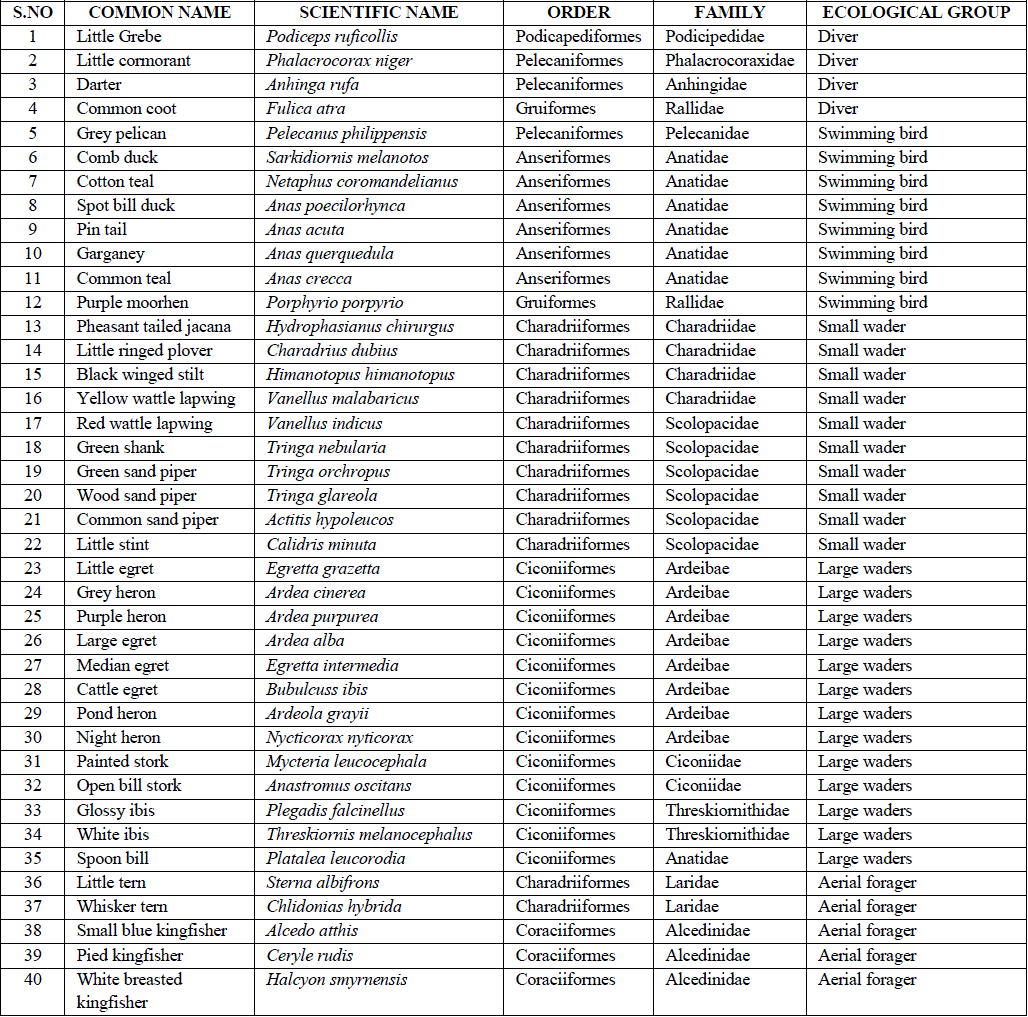 |
| Table. 2 Physico-chemical analysis of water from the Lake Udhayamarthandapuram |
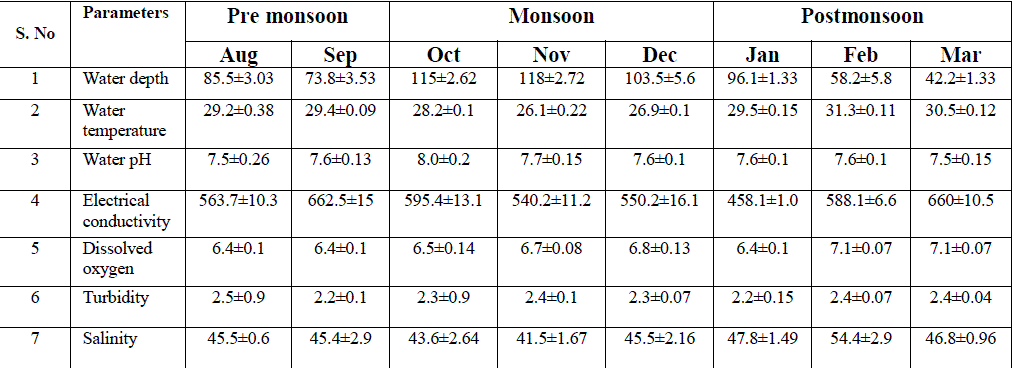 |
| Relationship of water quality parameter with water bird population Density of water birds: The correlation between water bird density and the water quality parameter revealed that the turbidity, Dissolved oxygen, salinity and electrical conductivity were negatively correlated. The pH and water depth were positively correlated. The temperature (-0.803) was negatively correlated at the significant level of P<0.05 and water depth (0.722) was positively correlated at the significant level of P<0.05 (Table 3). Diversity water birds: Relationship between the diversity of total water bird and the water quality variables revealed that the electrical conductivity, dissolved oxygen, turbidity and salinity levels were negatively correlated in the study period. The pH level was positively correlated. The temperature (-0.88) level was negatively correlated and its significant level of P<0.05. The water depth (0.818) was positively correlated and significant level of P<0.05 (Table 3). Richness of water birds: The correlation between the water bird richness and the water quality variation revealed that the temperature (-0.85) was negatively significant and its significant level of P<0.01. The electrical conductivity (-0.709) was negatively correlated at the significantly level of P<0.01. The pH (0.7) was positively significant of P<0.05. The depth level was positively correlated and the dissolved oxygen, salinity and turbidity levels were negatively correlated in the study period (Table 3). |
| Table 3. Correlation between water bird density, diversity, richness and water quality parameters at the Udhayamarthandapuram bird sanctuary |
 |
| *. Correlation is significant at the 0.05 level (2-tailed) **. Correlation is significant at the 0.01 level (2-tailed). |
| All the water quality factors studies were found to be significantly influence one or more water bird population characteristics. Sampath and Krishnamoorthy [30] were reported on the effect of water quality factors which the water bird in a wetland. In the present study the correlation between the water bird richness and the water quality variation revealed that the temperature was negatively significant. The electrical conductivity was negatively correlated at the significantly. The pH was positively significant of P<0.05. The depth level was positively correlated and the dissolved oxygen, salinity and turbidity levels were negatively correlated in the study period. The present study concluded that the importance of the Udhayamarthandapuram Lake as they prove to be the important feeding ground for the migratory and the resident species of the birds. All the groups of birds were with care use the lake in terms of density, diversity and richness. Moreover various abiotic parameters play an important role to make up the density, diversity and richness of the water birds hence indicating a single abiotic factor is unfeasible. Thus it can be concluded that the variation in the water quality and the availability of different prey determined the distribution and diversity of aquatic birds in the Lake during the study period. |
References |
|